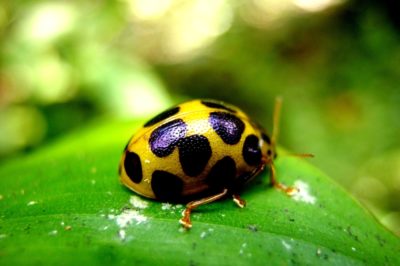Identifying Squash Beetles
Known also as squash ladybugs or squash lady beetles, the squash beetle has distinctive markings that make identification simple. Ridding the garden of this pest, not the beneficial ladybug, starts with knowing the differences between them.
Adult Stage
The squash beetle’s yellowish-orange dome-like shaped body is approximately 3/8 inches long, slightly larger than a ladybug. Its body is dotted with seven large spots on each forewing and four small black spots on the thorax. The squash beetle’s head is the same color as its body.
Egg Stage
The harmful squash beetle and the helpful ladybug adults look different, unlike the eggs’ appearance. Both lay clusters of 30-40 yellow oblong eggs on the underside of leaves. Removing the eggs from the leaves may reduce or eliminate the ladybug population.
Larva Stage
The larvae are small yellow oval-shaped with black spines sticking upward from their backs. Larvae of squash beetles eat on the underside of leaves potentially doing great damage to the plant.
Pupa Stage
The pupae of squash beetles are plump yellow grubs that feast on the underside of leaves. On the pupae, there are black spines left over from the larval stage that excrete an oily chemical, a deterrent to predators such as ants.
Methods of Removing Squash Beetles
Squash beetles are not usually a major problem to squash plants, but still should be controlled. Once identified, the numbers of these pests can be reduced in various ways.
Homemade Solution
Sometimes the most effective insecticide is homemade. North Dakota State University Extension Service recommends making a liquid spray that is effective against squash beetles. Here are the instructions for making this homemade insecticide:
- Mash together one garlic clove, one large onion, one cayenne, jalapeno or habanero pepper.
- Cover with 1 quart of water.
- Allow mixture to stand for at least 60 minutes.
- Strain the mixture.
- Mix in 1 tablespoon of dish soap.
- Pour the mixture into a spray bottle.
- Spray the solution unto the squash beetles.
Handpick the Beetles
An effective method of eliminating squash beetles is to pick them off the plants. Fill a jar with water and dish soap. Put the squash beetles in the jar and soon they will perish.
Rotate Crops
Most experts suggest not planting cucurbit crops in the same location two years in a row. Purdue State University suggests planting only once every three years. This will confuse the squash beetles and deter them from returning to your garden.
